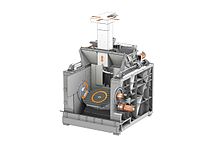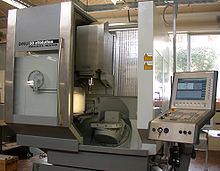Machining center
A machining center (BAZ) , also known as a manufacturing center, is a machine tool that is suitable for complete machining, i.e. it includes the functions of a lathe , milling machine and drilling machine . It also has an automatic tool change. Machining centers with an additional automatic workpiece change are called flexible manufacturing cells. If the structural basis of the machining center is a lathe, it is also referred to as a turning center , with a workpiece changer as a turning cell . Without certain additions, machining centers are usually designed on the basis of a milling machine. Compared to universal machines and CNC machines, machining centers have a higher productivity but less flexibility and are therefore suitable for the production of small and medium-sized series. For large-scale and mass production, transfer lines , automatic lathes or rotary transfer machines are used, which are more productive but less flexible than machining centers. The world's first NC-controlled machining center was presented in 1959 by the Reutlingen-based company Burkhardt + Weber and had a punched tape control .
description
Machining centers are differentiated according to the direction of the main spindle ( horizontal machining centers or vertical machining centers). Another distinguishing criterion is the number of axes .
In addition to the machining centers with one work spindle, there are also increasingly multi-spindle machining centers. These machining centers then have two, three or four spindles. A four-spindle machining center is then used to machine four workpieces at the same time. These machines are increasingly used for the production of larger batches. If parts are milled from solid, the raw material is usually held in two centrically clamping universal chucks. This results in very little retooling, as the same chuck is used for all part variants.
Complex geometries that are laborious to machine can now also be machined with multiple spindles. Five-axis simultaneous machining on multi-spindle machining centers is also possible and has been tested today. In the case of complex cast parts (aluminum or steel), machining usually takes several minutes - or even hours. By manufacturing with multi-spindle machining centers, the output can be increased significantly in relation to the area required by the machine.
All the advantages of multi-spindle machining compared to single-spindle machining:
- higher output per m² of floor space
- Reduction in labor costs as fewer machines need to be installed
- Lower "life cycle costs"
- highest productivity
Machining centers can be equipped with rotating and swiveling machine tables to expand their functionality so that one or two additional axes are available in them. The latest machines can even be used to carry out demanding filming work on rotating tables.
Machining centers are characterized by an automatic tool and workpiece changer. The tool change times or chip-to-chip times are sometimes under three seconds in modern machining centers, which significantly shortens cycle times.
swell
- ↑ swp.de: Industriemagazin - The real story of inventors and creators , accessed on July 10, 2019
- ↑ EMO Hannover: Reduced to the maximum , accessed on July 10, 2019
- ^ A b Walter Frick: Evolutionary improvements. In: Machine Market. Vogel Industrie Medien GmbH & Co. KG, 2006, edition 8, p. 18
- ↑ Homepage ( page can no longer be accessed , search in web archives ) Info: The link was automatically marked as defective. Please check the link according to the instructions and then remove this notice. of Schwäbische Werkzeugmaschinen GmbH - Zerspanung, accessed on February 27, 2012

